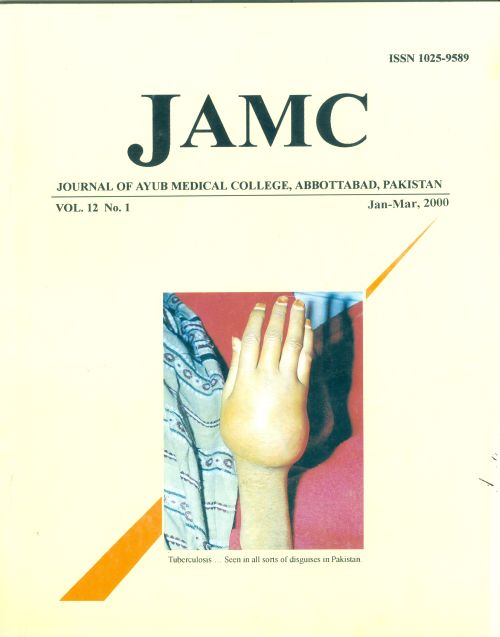TYPHOID ENTERIC PERFORATION: PROGNOSTIC FACTORS AN EXPERIENCE WITH 76 PATIENTS
Abstract
Background: In spite of the world wide improvement in public awareness of hygiene and good sanitation there arestill some parts of the world where the number of typhoid enteric perforation is rising day by day. Typhoid enteric
perforation if on one hand is a cause of increased morbidity and mortality for the patients, on the other hand it is
becoming a common surgical problem for the surgeon. Methods: A retrospective study of 76 patients of typhoid
enteric perforation was carried out with the aim to evaluate the factors contributing to the increasing incidence &
delayed diagnosis of the disease. More specifically the various surgical procedures used for the treatment of typhoid
enteric perforation & its results were evaluated. All the 76 patients w-ere admitted in the Surgical "C" Unit of Khyber
Teaching Hospital from January 1991 to Dec 1994. Results: The highest incidence was found in the second decade
of life (36.84%). Male to female ratio was 2.1. The common presenting symptoms were fever (100%) followed by
pain abdomen (76.31%). The Widal test was positive only in 71 patients while gas under the diaphragm was found in
45 cases. At Laparotomy 74 patients (97.36%) were found to have ileal perforation as compared to jejunal perforation
in 2 cases. Faecal peritonitis was observed in 54 (59.21%). In 59 patients primary closure of the perforation was
performed. While in 11 patient's exteriorization of perforation as temporary ileostomy was performed. 12 patients out
of 59 with primary closure of the perforation re-perforated and added to considerable postoperative morbidity and
mortality. On the other hand, 11 patients with the primary exteriorization of perforation as temporary ileostomy did
very well The overall mortality rate was (22.35%). Conclusion: Early diagnosis and primary exteriorization of the
perforation as temporary ileostomy can decrease morbidity and mortality considerably.
References
Gibney-EJ. Typhoid perforation. Br. J. Surg. 1990
Feh:77(2) 234.
Jemi-L, Mehdi-A. chakroun-M, Chatti-N Djaidana-A.
less complications La fever typhoid. Med Trop-Mars
: 49(2): 189-91.
Meier De, perforated Typhoid enteritis, operative
experience with 108 cases. Ann-J-Surg. 1989 157(4):
-7.
Wan-der-Web-ts. Careron-FB. Typhoid perforations of
the ileum. A review of 59 cases. Trop-Geogr-Med.
: 42(4): 330-6.
Gingh-KP. Singh-K Kohli-Js Choice of Surgical
Procedures in typhoid Perforation, experience in 42
cases. J-India- Med.Asso.1991 Sep: 89(9) =255-6.
Richards-J Management of Bowel perforation in
typhoid fever. Trop-Doct. 1991:21 (4) 149-52.
Sharma-L Gupta-s Soin- As, Sikora-S Kapoor-V
Generalized peritonitis in India. JPN-J Surg.
(3): 272-7.
Xduhuba-DA. Erhabor DE. . Akinola-DO, Typhoid &
paratyphoid Fever a retrospective study. TropGastroenterol- 1992: 12(2): 56-63
Mock-CN, Amaral-J. Visser-LE. Improvement in
survival, from typhoid enteric perforations results of
operative cases. Ann-surg.1992 Mar: 21(3): 244-9.
Mechat-F-Zeruoali-On. Non Traumatic perforation of
small intestine. 1993: 130(6):292-6.
Thomas SS, Mammen KJ, Eggleston FC. Typhoid
Perforation, Further experience with end to side
Ileotransverse colostomy. India Trop-Doct. 1990 20
(3): 126- 8.
Nguyen VS. Typhoid perforations in tropics Apopas of
cases. J-Chir-Paris. 1994 Feb, 131(2)90-5.
Gupta V, Gupta SK, Shukla VK, Gupta S Perforated
typhoid enteritis in children. India Postgrad-Med-J
jan 70(819)19-22.
Akoh-JA Prognostic factors in typhoid perforations
Afr-Med- J 1993:70(1)18-21.
How to Cite
Issue
Section
License
Journal of Ayub Medical College, Abbottabad is an OPEN ACCESS JOURNAL which means that all content is FREELY available without charge to all users whether registered with the journal or not. The work published by J Ayub Med Coll Abbottabad is licensed and distributed under the creative commons License CC BY ND Attribution-NoDerivs. Material printed in this journal is OPEN to access, and are FREE for use in academic and research work with proper citation. J Ayub Med Coll Abbottabad accepts only original material for publication with the understanding that except for abstracts, no part of the data has been published or will be submitted for publication elsewhere before appearing in J Ayub Med Coll Abbottabad. The Editorial Board of J Ayub Med Coll Abbottabad makes every effort to ensure the accuracy and authenticity of material printed in J Ayub Med Coll Abbottabad. However, conclusions and statements expressed are views of the authors and do not reflect the opinion/policy of J Ayub Med Coll Abbottabad or the Editorial Board.
USERS are allowed to read, download, copy, distribute, print, search, or link to the full texts of the articles, or use them for any other lawful purpose, without asking prior permission from the publisher or the author. This is in accordance with the BOAI definition of open access.
AUTHORS retain the rights of free downloading/unlimited e-print of full text and sharing/disseminating the article without any restriction, by any means including twitter, scholarly collaboration networks such as ResearchGate, Academia.eu, and social media sites such as Twitter, LinkedIn, Google Scholar and any other professional or academic networking site.










